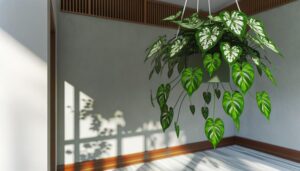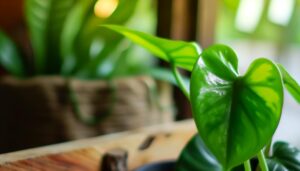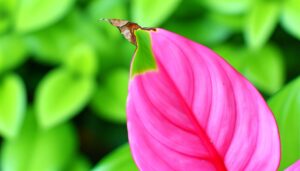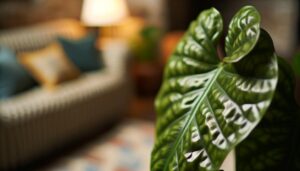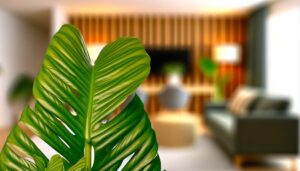What Is Philodendron Bipinnatifidum Atom?
Philodendron bipinnatifidum 'Atom' is a compact, tropical plant cultivated for its ornamental appeal. Originating from South America, it features glossy, deeply lobed leaves with a ruffled, feather-like texture and rich green hue.
Typically achieving a height of 30 to 60 centimeters, its bushy growth habit makes it suitable for indoor environments with limited space. This species thrives in consistently moist but well-drained soil, benefiting from regular pruning and balanced fertilizer.
It has notable air-purifying properties and a robust structure. For more insights into its maintenance and propagation, further information is provided.
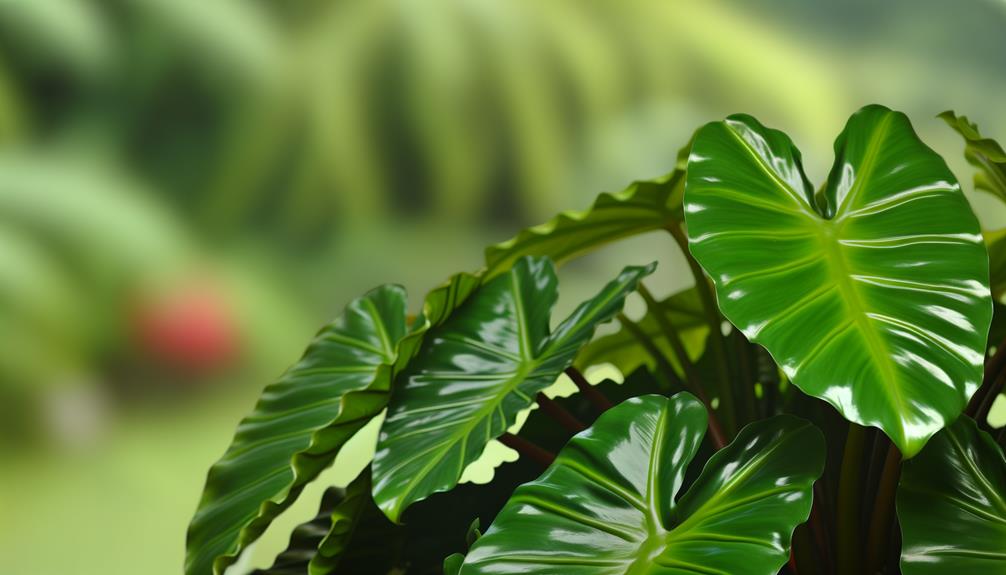
Key Takeaways
- Philodendron Bipinnatifidum Atom is a compact, ornamental plant known for its deeply lobed, glossy green leaves with a ruffled texture.
- It grows to a height of 30 to 60 centimeters and is ideal for limited indoor spaces.
- Native to tropical South America, particularly Brazil, it is selectively cultivated for indoor horticulture.
- The plant thrives in consistently moist but well-drained soil and requires minimal maintenance.
- It offers air-purifying benefits by removing toxins like formaldehyde and benzene from indoor environments.
Plant Description
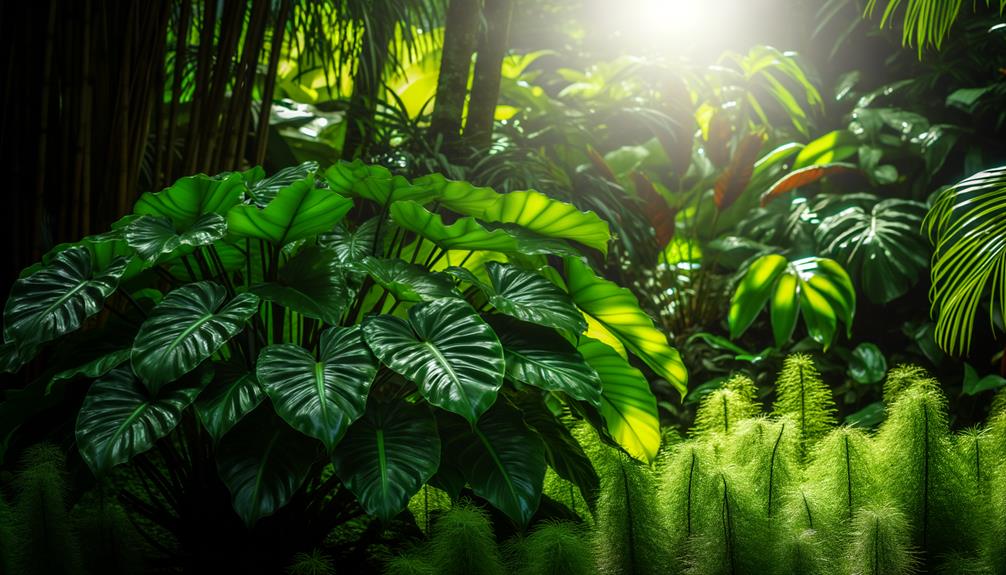
Philodendron bipinnatifidum 'Atom' is a compact, evergreen perennial characterized by its deeply lobed, glossy green leaves that exhibit a distinctive, wavy margin.
The leaves are smaller and more clustered compared to its larger relatives, creating a dense, bushy appearance. This cultivar typically reaches a height of 30 to 60 centimeters, making it well-suited for indoor environments.
Each leaf blade is intricately divided, with pinnatifid lobes that contribute to its ornamental value. The stems are sturdy and support the foliage, which is known for its robust texture and resilience.
Philodendron bipinnatifidum 'Atom' exhibits a clumping growth habit, and its compact size makes it an ideal choice for limited spaces, offering both aesthetic appeal and ease of maintenance.
Origins and History
Native to the tropical regions of South America, particularly Brazil, Philodendron bipinnatifidum 'Atom' has been selectively cultivated for its compact growth habit and ornamental foliage.
This cultivar originates from the larger Philodendron bipinnatifidum species, which thrives in humid, shaded environments of the Brazilian rainforests.
The 'Atom' variety was developed to cater to indoor horticulture enthusiasts seeking a manageable plant size without sacrificing the aesthetic appeal of the species' deeply lobed, glossy leaves.
Over time, horticulturists have refined this cultivar for resilience and adaptability to indoor conditions. Its precise breeding history remains somewhat obscure, but its lineage can be traced back to the rich biodiversity of South American flora, where it continues to be a prized specimen in botanical collections.
Unique Characteristics
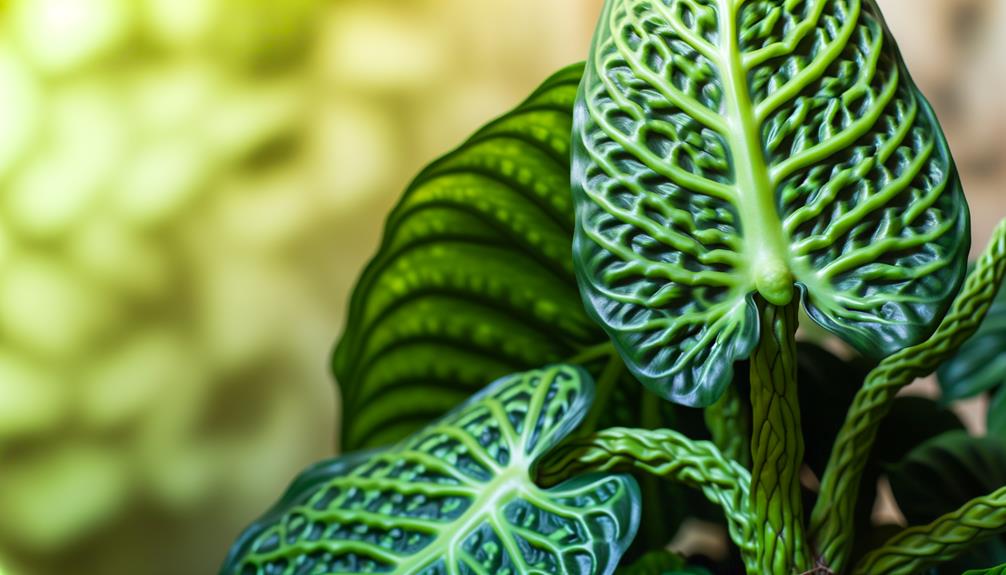
The Philodendron bipinnatifidum 'Atom' is distinguished by its deeply lobed, glossy green leaves, which exhibit a unique ruffled texture.
This compact, slow-growing cultivar requires specific care, including moderate light and consistent watering to maintain its lush appearance.
Understanding these unique characteristics is essential for best growth and maintenance of this ornamental plant.
Leaf Shape and Texture
Characterized by deeply lobed, pinnatifid leaves, the Philodendron bipinnatifidum 'Atom' exhibits a distinctive texture that is both glossy and leathery, contributing to its unique aesthetic appeal.
The leaves of this cultivar are intricately divided into multiple, deep segments, creating a feather-like appearance. Each leaf bears a rich, green hue, which enhances its lustrous surface.
The leathery texture provides a robust feel, indicative of the plant's ability to withstand varying environmental conditions. The glossy finish of the leaves not only adds to the plant's visual allure but also assists in optimizing light absorption.
This combination of morphological and textural qualities makes the Philodendron bipinnatifidum 'Atom' a remarkable specimen in both horticultural and interior design contexts.
Growth and Maintenance
Philodendron bipinnatifidum 'Atom' demonstrates a compact growth habit, making it an ideal choice for indoor environments where space optimization is crucial.
This cultivar, a dwarf variant of the larger Philodendron bipinnatifidum, typically reaches a height of up to 30 centimeters. Its slow growth rate and dense foliage result in a bushy appearance, reducing the need for frequent pruning.
The plant's internodes are short, leading to closely spaced leaves that create a fuller look. Regular maintenance involves removing dead or yellowing leaves to maintain its aesthetic appeal and prevent disease.
Additionally, repotting every 1-2 years guarantees the root system has adequate space to develop, promoting overall plant health. This low-maintenance species adapts well to various indoor conditions, enhancing its appeal.
Light and Water Needs
Perfect growth of Philodendron bipinnatifidum 'Atom' requires bright, indirect light and consistent moisture levels, guaranteeing the plant receives the right balance for its unique physiological needs.
This cultivar thrives best under the following conditions:
- Light: Exposure to filtered sunlight is ideal, avoiding direct sun which can scorch the foliage.
- Water: Maintain evenly moist soil, guaranteeing it is neither waterlogged nor too dry. Allow the top inch of soil to dry out between watering.
- Humidity: High humidity levels, around 60-70%, support healthy growth, mimicking its native tropical environment.
These conditions facilitate the plant's robust growth, large, lobed leaves, and overall importance.
Consistent monitoring and adjustment of these factors will guarantee the Philodendron bipinnatifidum 'Atom' remains vibrant and resilient.
Ideal Growing Conditions
Philodendron bipinnatifidum 'Atom' thrives in bright, indirect light and temperatures ranging from 18°C to 27°C.
Best growth is achieved with consistent moisture, high humidity levels, and well-draining soil rich in organic matter.
Regular fertilization during the growing season guarantees robust development and vibrant foliage.
Light and Temperature Needs
Thriving best in bright, indirect light, Philodendron bipinnatifidum 'Atom' requires temperatures consistently maintained between 65°F and 80°F for ideal growth. This species, known for its lush, deeply lobed foliage, demands specific environmental conditions to flourish.
To ensure prime light and temperature:
- Light Intensity: Place the plant in an area with filtered sunlight to prevent leaf burn while guaranteeing sufficient photosynthesis.
- Temperature Stability: Maintain a constant indoor temperature, avoiding sudden fluctuations that could stress the plant.
- Seasonal Considerations: During colder months, maintain the plant in a warm, draft-free environment to prevent chilling injury.
Understanding these requirements helps in cultivating a healthy Philodendron bipinnatifidum 'Atom', ensuring vigorous growth and vibrant foliage.
Watering and Humidity Requirements
Maintaining ideal watering and humidity levels is essential for the robust growth of Philodendron bipinnatifidum 'Atom', complementing its light and temperature preferences. This species thrives in consistently moist soil without becoming waterlogged. Overwatering can lead to root rot, so ensuring proper drainage is necessary.
Watering should be done when the top inch of the soil feels dry. Humidity levels between 60-80% are best, replicating its native tropical environment. Utilizing a humidifier or placing the plant on a pebble tray with water can help maintain these conditions. Periodically misting the leaves can also increase humidity.
Observing the plant's foliage can provide indicators of its hydration needs; drooping leaves often signify either overwatering or underwatering.
Soil and Fertilization
A well-draining soil mix, rich in organic matter, is essential for the ideal growth of Philodendron bipinnatifidum 'Atom'. This compact cultivar thrives best in soil that mimics its natural tropical habitat.
To achieve peak growth conditions, consider the following:
- Soil Composition: A blend of peat, perlite, and pine bark guarantees sufficient drainage and aeration.
- pH Levels: Maintain a slightly acidic to neutral pH (5.5 to 7.0) to support nutrient uptake.
- Fertilization: Use a balanced, water-soluble fertilizer with an NPK ratio of 20-20-20, applied monthly during the growing season.
These measures will provide the necessary nutrients and environment for 'Atom' to flourish, promoting healthy foliage and robust development.
Watering and Feeding
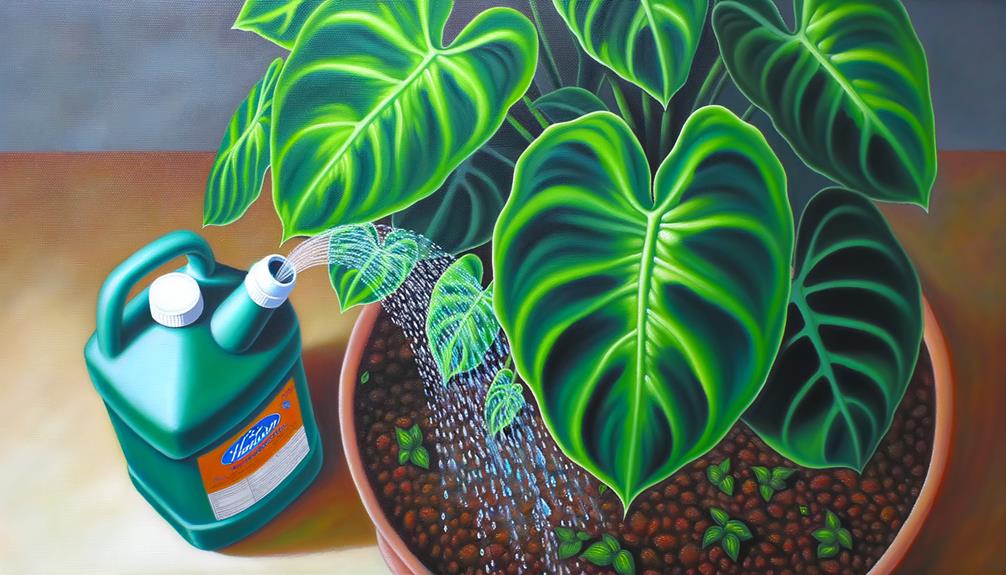
Ensuring ideal hydration and nutrient intake for Philodendron bipinnatifidum 'Atom' involves a careful balance tailored to its unique physiological needs. This tropical perennial thrives in consistently moist but well-drained soil. Overwatering can lead to root rot, while underwatering may cause wilting and leaf discoloration.
Employ a deep watering method, allowing excess water to drain, and let the top inch of soil dry out between waterings. Regarding feeding, a balanced, water-soluble fertilizer with an N-P-K ratio of 20-20-20 is recommended. Apply this biweekly during the growing season (spring through early autumn) and reduce frequency during dormancy in the cooler months.
Adhering to this regimen supports robust growth and vibrant foliage, characteristic of this species.
Common Pests and Diseases
While proper watering and feeding are essential for the health of Philodendron bipinnatifidum 'Atom', it is also imperative to remain vigilant against common pests and diseases that can compromise its well-being.
Among the most prevalent issues are:
- Spider Mites (Tetranychus urticae): These tiny arachnids suck sap from the leaves, causing stippling and potential defoliation.
- Mealybugs (Pseudococcidae family): These pests appear as white, cotton-like masses and excrete honeydew, promoting sooty mold.
- Root Rot (Phytophthora spp.): Overwatering can lead to this fungal infection, characterized by black, mushy roots and yellowing leaves.
Effective management requires regular inspection, maintaining proper humidity levels, and using appropriate insecticides or fungicides when necessary. Early intervention is key to preventing severe damage.
Propagation Methods
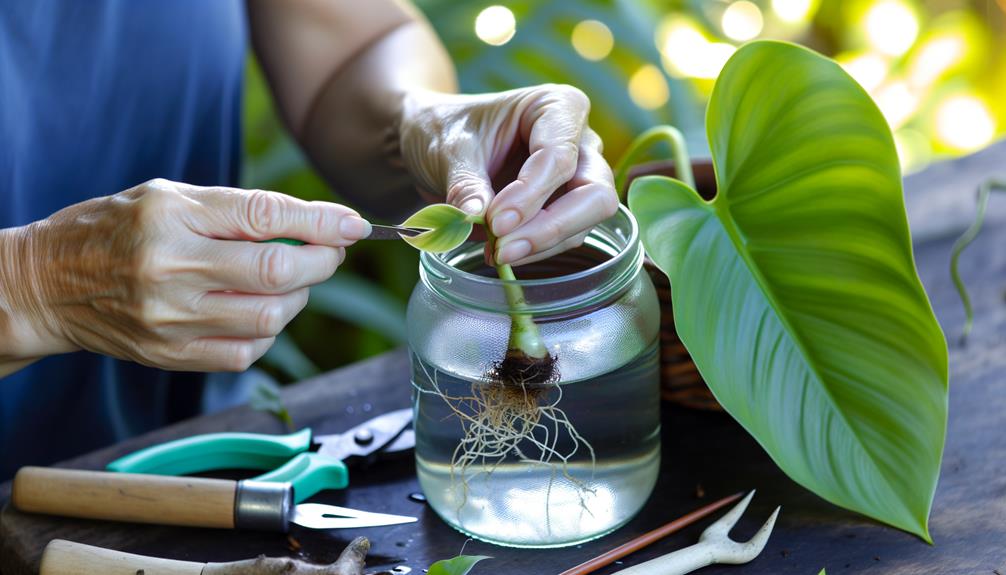
Propagation of Philodendron bipinnatifidum 'Atom' can be effectively achieved through stem cuttings or air layering. Both methods require careful attention to moisture and temperature conditions.
Stem cuttings should be taken from healthy, mature plants, ensuring each cutting includes at least one node. These cuttings are then placed in a well-draining propagation medium, maintaining consistent humidity and temperatures between 70-85°F (21-29°C).
Air layering involves making a small incision on a healthy stem, wrapping it with moist sphagnum moss, and covering it with plastic to retain moisture. Roots usually develop within a few weeks, after which the new plant can be separated and potted.
Both methods necessitate sterile tools to prevent disease transmission.
Benefits of Growing
Cultivating Philodendron bipinnatifidum 'Atom' offers numerous advantages, including its air-purifying properties and the aesthetic appeal of its lush, compact foliage. The species is particularly adept at removing common indoor pollutants, enhancing indoor air quality.
Its dense, ruffled leaves provide visual interest, making it a standout feature in any interior space. Additionally, this plant is relatively low-maintenance, thriving in a range of light conditions and requiring minimal watering.
Key benefits include:
- Air Purification: Effectively removes formaldehyde, benzene, and other toxins.
- Aesthetic Enhancement: Compact growth habit and rich green foliage add elegance.
- Low Maintenance: Adaptable to various light levels and infrequent watering needs.
These attributes make Philodendron bipinnatifidum 'Atom' an ideal choice for both novice and experienced plant enthusiasts.
Conclusion
Philodendron bipinnatifidum 'Atom' is a notable cultivar that thrives in diverse environments due to its adaptability and resilience.
One particularly fascinating statistic is that a single mature plant can produce up to 500 leaves in ideal conditions, highlighting its vigorous growth potential.
This species' robust foliage, combined with its minimal maintenance requirements, makes it an excellent choice for both novice and experienced horticulturists seeking to enhance indoor or outdoor botanical collections.

